|
|
DELHI RAJ
GHAT
 North-east of Feroz Shah Kotla, on the banks of the Yamuna, a simple
square platform of black marble the spot where Mahatma Gandhi was cremated
following his assassination in 1948.A commemorative ceremony takes place
each Fridays, the day he was killed. North-east of Feroz Shah Kotla, on the banks of the Yamuna, a simple
square platform of black marble the spot where Mahatma Gandhi was cremated
following his assassination in 1948.A commemorative ceremony takes place
each Fridays, the day he was killed.
The Raj Ghat area is now a
beautiful park, complete with labelled trees planted by a mixed bag of
notables including Queen Elizabeth II, Gough Whitlam, Dwight Eisenhower
and Ho Chi Minh!
SHANTI
VANA
On the banks of the river Yamuna are the National Shrines. Jawaharlal
Nehru, the first Indian prime minister, was cremated just to the north at
Shanti Vana (Forest of Peace) in 1964. His daughter, Indira Gandhi, who
was killed in 1984, and grandsons Sanjay (1980) and Rajiv (1991) were also
cremated in this vicinity.
JAMA
MASJID
The great mosque of Old Delhi is both the largest in India and the final
architectural extravagance of Shah Jahan. Commenced in 1644, the mosque
was not completed until 1658. It has three great gateways, four angle
towers and two minarets standing 40 metres high and constructed of
alternating vertical strips of red sandstone and white marble.
Board flights of
steps lead up to the imposing gateways. The eastern gateways was
originally only opened for the emperor, and is now only open on Fridays
and Muslim festival days. The general public can enter by either the north
or south gate. Shoes should be removed and those people considered
unsuitably dressed (bare legs for either men and women) can hire robes at
the northern gate.
The courtyard of the mosque
has a capacity of 25,000 people. It’s possible to climb the southern
minaret, and the views in all directions are superb – Old Delhi, the Red
Fort and New Delhi- Jama
Masjid, Connaught Place and Sansad Bhavan (Parliament House) are in a
direct line. There’s also a fine view of the Red Fort from the east side
of the mosque.
RED
FORT
The red sandstone walls of Lal Quila, the Red Fort, extended for two km in
height from 18 metres on the riverside to 33 metres on the city side. Shah
Jahan started construction of the massive fort in 1638 and it was
completed in 1648. He never completely moved his capital from Agra to his
new city of Shahjahanabad in Delhi because he was deposed and imprisoned
in Agra Fort by his son Aurangzeb.
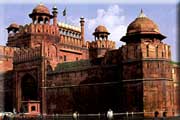
The Red Fort dates from the very
peak of Mughal power. When the emperor rode out on elephant-back into the
streets of Old Delhi it was a display of pomp and power at its most
magnificent. The Mughal reign from Delhi was a short one, however
Aurangzeb was the first and last great Mughal emperor to rule from here.
Today, the fort is typically
Indian with would-be guides leaping forth their services as soon as you
enter. It’s still a calm haven of peace if you’ve just left the
frantic streets of Old Delhi, however. The city noise and confusion are
light years away from the fort gardens and pavilions. The Yamuna River
used to flow right by the eastern edge of the fort, and filled the
10-metre-deep moat. These days the rivers is over one km to the east and
the moat remains empty.
LAHORE
GATE
The main gate to the fort takes its name from the fact that
it faces towards Lahore, now in Pakistan. If one spot could be said to be
the emotional and symbolic heart of the modern Indian nation, the Lahore
Gate of the Red Fort is probably it.
The arcade leads to the Naubat
Khana, or Drum House, where musicians used to play for the emperor,
and the arrival of princes and royalty was heralded from here. There’s a
dusty Indian War Memorial museum upstairs. The open courtyards beyond the
Drum House formerly had galleries along either side, but these were
removed by the British army when the fort was used as its headquarters.
Other reminders of the British presence are the monumentally ugly, three-
storeys barrack blocks that lie to the north of this courtyard.
CHANDNI
CHOWK
The main street of Old Delhi is the colourful shopping bazaar known as
Chandni Chowk.
At the eastern (Red Fort) end of Chandni Chowk, there is a Digambara
Jain Gurdwara (temple), with a small marble courtyard surrounded by a
colonnade. Traditionally, Jain monks of he Digambara, or Sky Clad, sect
wore no garments. There’s an interesting bird hospital here, rub
by the Jains.
QUTAB
MINAR COMPLEX
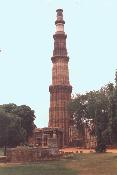 The buildings in this complex, 15km south of Delhi, date from the
onset of Muslim rule in India and are fine example of early – Afghan
architecture. The Qutab Minar itself is a soaring tower of victory which
was started in 1193, immediately after the defeat of the last Hindu
kingdom in Delhi. It is nearly 73 metres high and tapers from a 15- metre
– diameter base to just 2.5 metres at the top. The buildings in this complex, 15km south of Delhi, date from the
onset of Muslim rule in India and are fine example of early – Afghan
architecture. The Qutab Minar itself is a soaring tower of victory which
was started in 1193, immediately after the defeat of the last Hindu
kingdom in Delhi. It is nearly 73 metres high and tapers from a 15- metre
– diameter base to just 2.5 metres at the top.
The tower has five distinct storeys,
each marked by a projecting balcony. The first three storeys are made of
red sandstone, the fourth and fifth of marble and sandstone. Although
Qutab-ud-din began construction of the tower, he only got to the first
storeys. His successors completed it and, in 1368,Feroz Shah Tughlaq
rebuilt the top storeys and added a cupola. An earthquake brought the
cupola down in 1803 and an Englishmen replaced it with another in 1829.
However, that dome was deemed inappropriate and was removed some years
later.
Today, this impressively
ornate tower has a slight tilt, but otherwise has worn the centuries
remarkably well. The tower is closed to visitors, and has been for some
years after a stampede during a school trip led to a number of deaths.
BAHAI
TEMPLE
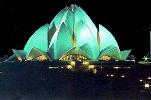 Lying to the east of Siri is this building shaped like a lotus flower.
Completed in 1986, it is set among pools and gardens, and adherents of any
faith are free to visit the temple and pray or meditate silently according
to their own religion. It looks spectacular at dusk, particularly form the
air, when it is floodlit, but is rather disappointing close up. The temple
lies just inside the Outer Ring Road, 12 km south-east of the city center. Lying to the east of Siri is this building shaped like a lotus flower.
Completed in 1986, it is set among pools and gardens, and adherents of any
faith are free to visit the temple and pray or meditate silently according
to their own religion. It looks spectacular at dusk, particularly form the
air, when it is floodlit, but is rather disappointing close up. The temple
lies just inside the Outer Ring Road, 12 km south-east of the city center.
Purana
Quila
Just south-east of India Gate and north of Humayun’s tomb and
Nizamuddin train station is the Purana Quila (Old Fort). This is the
supposed site of Indraprastha, the original city of Delhi. The Afghan
ruler, Sher Shah, who briefly interrupted the Mughal sovereignty by
defeating Humayun, completed the fort during his reign from 1538 to 1545,
before Humayun regained control fo India. The fort has massive walls and
three large gateways.
Entering form the south gate you’ll see the small octagonal
red sandstone tower, the Sher Mandal, later used by Humayun as a library.
It was while descending the staris of this tower one day in 1556 that he
slipped, fell and received injuries from which he later died. Just beyond
it is the Qila-I-Kuhran Mosque, or Mosque of Sher Shah, which, unlike the
fort itself, is in a reasonable condition.
There’ s a small archaeological museum just inside the
main gate, and there are good views of New Delhi form atop the gate.
SAFDARJANG’S
TOMB
Beside the small Safadarjang airport, this tomb was built in 1753-54 by
the Nawab of Avadh for his father, Safdarjang, and is one for the last
examples of Mughal architecture before the final remnants of the great
empire collapsed. The tomb stands on a high terrace surrounded by and
extensive walled garden. It makes a pleasant retreat form the urban
bustle.
HUMAYUN’S
TOMB
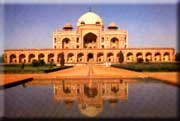 Built in the mid-16th century by Haji Begum, senior wife of
Humayun, the second Mughal emperor, this is an early example of Mughal
architecture. The elements in its design – a squat building, lighted by
high arched entrances, topped by a bulbous dome and surrounded by formal
gardens – where to be refined over the years to the magnificence of the
Taj Mahal in Agra. This
earlier tomb is thus of great interest of its
relation to the later Taj. Humayun’s wife is also buried in the
red-and-white sandstone, black-and-yellow marble tomb. Built in the mid-16th century by Haji Begum, senior wife of
Humayun, the second Mughal emperor, this is an early example of Mughal
architecture. The elements in its design – a squat building, lighted by
high arched entrances, topped by a bulbous dome and surrounded by formal
gardens – where to be refined over the years to the magnificence of the
Taj Mahal in Agra. This
earlier tomb is thus of great interest of its
relation to the later Taj. Humayun’s wife is also buried in the
red-and-white sandstone, black-and-yellow marble tomb.
Other tombs in the garden include that of Humayun’s
barber and the Tomb of Isa Khan, a good example of Lodhi architecture.
An excellent view can be obtained over the surrounding country from the
terraces of the tomb.
INDIA
GATE (War Memorial Arch)
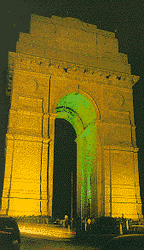 This 42- metres- high stone arch of triumph stands at the eastern end
of the Rajpath. It bears the name of 85,000 Indian Army soldiers who died
in the campaigns of W W I, the North-West Frontier operations of the same
time and the 1919 Afghan fiasco. This 42- metres- high stone arch of triumph stands at the eastern end
of the Rajpath. It bears the name of 85,000 Indian Army soldiers who died
in the campaigns of W W I, the North-West Frontier operations of the same
time and the 1919 Afghan fiasco.
The structural has an eternal fame (Amar Jawan Jyoti) to honour the memory
of the Indian Army.
JANTAR
MANTAR
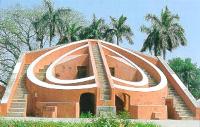 Only a short stroll down Sansad Marg from Connaught Place, this
strange collection of salmon-coloured structures is one of Maharaja Jai
Singh II’s observatories. The ruler form Jaipur constructed this
observatory in 1725 and it is dominated by a huge sundial known as the
Prince of Dials. Other instruments plot the course of heavenly bodies and
predict eclipses. Only a short stroll down Sansad Marg from Connaught Place, this
strange collection of salmon-coloured structures is one of Maharaja Jai
Singh II’s observatories. The ruler form Jaipur constructed this
observatory in 1725 and it is dominated by a huge sundial known as the
Prince of Dials. Other instruments plot the course of heavenly bodies and
predict eclipses.
 LAKSHMI
NARAYAN TEMPLE LAKSHMI
NARAYAN TEMPLE
Situated due west of Connaught Place, this garish modern temple was
erected by the industrialist B D Birla in 1938. It’s dedicated to Lord
Krishna and his consort Lakshmi, the goddess of wealth and is commonly
known as Birla Mandir.
PRESIDENT’S
HOUSE (Rashtrapati Bhavan)

The official residence of the President of India stands at the opposite
end of the Rajpath from India Gate. Completed in 1929, the place- like
building is a blend of Mughal and Western architectural styles, the most
obvious Indian feature being the huge copper dome. To which occupies 130
hectares, and this is open to the public in February.
Prior to
Independence this was the viceroy’s residence. At the time of
Mountbatten, India’s last viceroy, the number of servants needed to
maintain the 340 rooms and its extensive gardens was enormous.
PARLIAMENT
HOUSE (Sansad Bhavan)
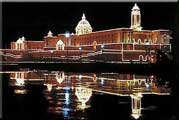
Although another large and imposing building, Sansad Bhavan, the Indian
parliament building, stands almost hidden and virtually unnoticed at the
end of Sansad Marg, or Parliament Street, just north of Rajpath. The
building is a circular colonnaded structure 171 metres in diameter. It’s
relative physical insignificance in the grand scheme of New Delhi shows
the viceroy’s residence, which was given pride of place during the time
of the British Raj when New Delhi was conceived.
Permits to visit the parliament and sit in
the public gallery are available from the reception office on Raisina
Road, but you’ll need a letter of introduction from your embassy.
GOVERNMENT
SECRETARIAT BUILDINGS
The north and south Secretariat buildings lie either side of Rajpath on
Raisina Hill. These imposing buildings, topped with chhatris
(small domes), now house the ministries of Finance and External
Affairs respectively.
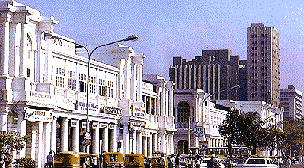 CONNAUGHT
PLACE SHOPPING CENTRE CONNAUGHT
PLACE SHOPPING CENTRE
Located at the northern end of New Delhi, Connaught Place is the business
and tourist centre. It’s a vast traffic circles with architecturally
uniform series of colonnaded buildings around the edge – mainly devoted
to shops, banks, restaurants, airline offices and the like. It’s
spacious but busy, and you’re continually approached by people willing
to provide you with everything imaginable, from an airline ticket for
Timbuktu to having your fortune read.
|





